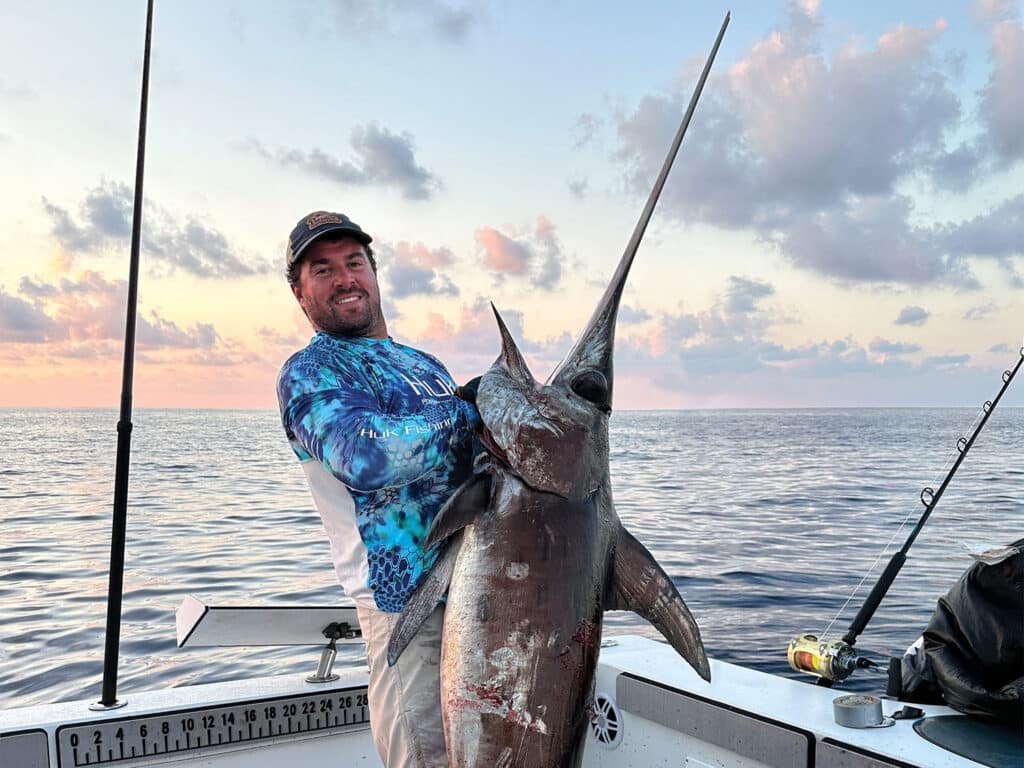
Special delivery: Sign up for the free Marlin email newsletter. Subscribe to Marlin magazine and get a year of highly collectible, keepsake editions – plus access to the digital edition and archives.
I never understood the term “purple fever” when I heard it in the past. Swordfishing legends such as RJ Boyle, Brett Holden and Peace Marvel used it in conversation, but I didn’t really know what it meant. I grew up inshore fishing and then eventually progressed to snapper, grouper and tuna, but I never had even the slightest clue that swordfish would hook me far more deeply than I’d ever hook them. I was in trouble—not the type involving law enforcement, but the type that would cost me lots of cash and a whole lot of time.
Years ago, I was fortunate to have multiple connections across southern Louisiana who would let me ride out in exchange for boat cleaning and deckhand work. I didn’t have the funds then, but I certainly had the drive and work ethic. I made myself an asset to have on any offshore fishing trip, but eventually found that I only wanted to do one thing, and that was fish for swords. Yep, I had tested positive for purple fever.
I had watched a few videos and at the time couldn’t understand how someone could stare at a rod tip for hours upon end. Snapper and grouper are different: If you put the right bait in their face, you’re going to get bit. Tuna, if you have the right bait and you’re at the right place at the right time, you’ll typically get a bite. Swords, though, are a different ballgame entirely.
Consider the patience needed to stitch a squid, belly strip or eel onto a 10/0 J hook, crimp it onto a homemade wind-on leader, cat’s-paw it onto the main line, add a wax loop for the weight or buoy to clip onto, then send the whole thing into the depths with a hope and a prayer that it doesn’t get tangled, and you’d believe someone a damn fool for even thinking they’d stick with it for more than a few drops. But I did, and still do. After being a professional guest fisherman for a while, I finally finished outfitting my dream boat, a 35-foot Nerowalker aluminum catamaran built in Louisiana. The boat powered by quad Suzuki 300s and equipped with top-of-the-line electronics from Garmin and Airmar, I felt that we were now a legitimate threat to the swords. First trip in the boat, I went all in, with a dozen rigged squids in a Grizzly cooler standing by, along with a half-ton of ice, four Shimano 80-Wides, 500 gallons of fuel and a case of Red Bull.
Joined by my buddies Justin Ziegler and Justin Toth, I departed from Coco Marina in Cocodrie, Louisiana, at 5 a.m. At 8 a.m., we arrived at my first spot and sent down a tip rod with squid and then another with belly strip. Ten minutes in, and the squid rod started bucking. We played the typical game of cat and mouse a few times, dropping back and then cranking up the bait to entice him to eat. On the second tease drop, we hooked him with the weight and came tight. Within 45 minutes of dropping our first bait, we had boated our first fish, which measured a solid 78 inches. The next 24 hours was like a swordfish home-run derby; in total, we went eight for nine on broadbills, with all fish measuring between 68 and 78 inches. I’ve had plenty of days catching two or three swordfish since then, but nothing quite as epic as that first trip.
Read next: Marlin Fishing in Venice, Louisiana.
Many different things must come together for us to make that full commitment. But oh, how I love it when a plan comes together! My boat is always ready to go, and my brain continually searches for better, more efficient ways of doing things, allowing me the time and money to go back out there and do it again the next day.
Some days it’s sword wishing, and others it’s swordfishing, but I’ve got to admit that having purple fever isn’t so bad.







